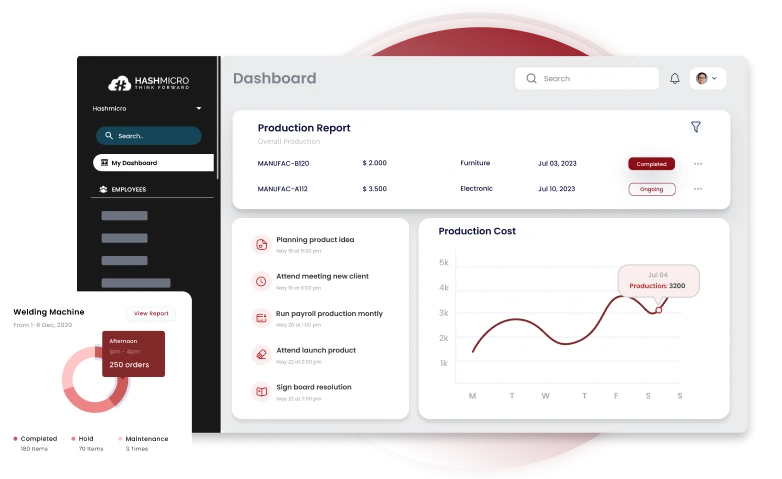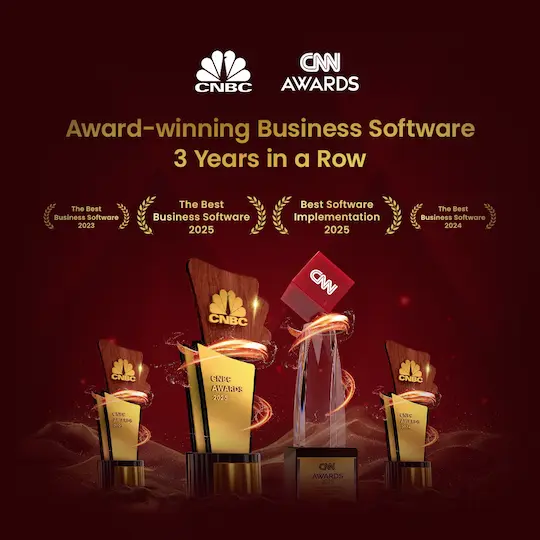Things don’t usually go wrong in manufacturing because someone made a huge mistake. Most of the time, it’s the small things: a material not arriving on time, a work order lost in someone’s inbox, or a team assuming someone else had it covered. That’s why manufacturing flow management matters.
According to recent studies, disruptions in production flow can reduce total output by as much as 8% of productivity annually. Without proper flow, even the most experienced teams spend more time fixing issues than moving forward.
However, here’s the good part: this kind of chaos isn’t permanent. So, how do you fix the broken flow? This article will walk you through the basics of manufacturing flow management, so you can understand how it works, where the common breakdowns happen, and what you can do to make it smoother.
Key Takeaways
|
Table of Contents

What is Process Flow?
A process flow illustrates how business operations unfold step by step, often presented in a chart or diagram so that employees can clearly understand their roles and responsibilities.
It typically covers:
- Key personnel involved
- Timeline or deadlines
- Necessary resources such as raw materials, machinery, or digital tools
Let’s take a look at a typical manufacturing example, often found within the industry. Suppose your company is rolling out a new product line (say, stainless steel cookware) and you need to set up a new production process.
A sample production process flow might include:
- Receive the product development brief from the R&D team
- Finalize technical drawings and material specifications
- Order raw materials (e.g., stainless steel sheets, handles, packaging)
- Prepare and calibrate production machinery
- Begin pilot production run for quality testing
- Conduct internal quality checks and make necessary adjustments
- Launch full-scale production after supervisor’s approval
What’s the Value of Creating a Process Flow?
The purpose of building a process flow is to bring consistency and efficiency to your daily operations and supply chain execution.
Here are a few benefits of process flows in manufacturing supply chains:
- Consistent workflows: Starting a new production run doesn’t require building procedures from scratch. You can reuse and adapt standardized processes to guide tasks within the right context.
- Clear documentation: A defined workflow is only effective if you remember how it operates. Document your steps before assigning responsibilities, so the process is transparent. It also helps onboard new factory staff with easy-to-follow references that keep them aligned.
- Accountability across teams: A well-visualized process helps team members clearly understand their roles and timelines, leading to better ownership and fewer miscommunications. Manufacturing schedules and task lists clarify who’s responsible and when.
- Operational efficiency: Streamlined processes reduce manual repetition. This not only increases production flexibility but also lowers costs by automating routine steps. Over time, it becomes easier to spot resource limitations, workflow bottlenecks, and project delays.
What is Manufacturing Flow Management?
Manufacturing flow management refers to the structured coordination of each stage in the product development lifecycle, from initial concept to final distribution. It helps manufacturing engineers standardize operations by defining each step clearly and identifying the resources required at every phase.
Effective manufacturing flow management also involves tracking measurable elements, especially inventory levels and production lead times. These data points enable teams to set performance benchmarks and define goals for continuous improvement.
Key elements of a manufacturing workflow include:
- Planning and product design: Creating detailed product designs and outlining production strategies, including required materials, labor, and equipment.
- Raw material procurement: Securing the necessary raw materials and components to initiate the manufacturing process.
- Production timeline planning: Developing a detailed schedule to organize production stages efficiently.
- Manufacturing and assembly: Carrying out the physical production process, such as machining, assembling, and verifying component integration.
- Product quality assurance: Conducting inspections and tests to confirm that finished goods meet the required quality standards and specifications.
- Packaging and logistics: Getting products ready for shipment, which includes packing, labeling, and coordinating delivery schedules.
- Stock management: Monitoring raw materials, work-in-progress items, and finished products to ensure efficient use of resources and prevent shortages.
- Equipment upkeep and support: Performing regular maintenance and addressing equipment issues to avoid disruptions in production.
When your production and PPIC teams work from the same data, you reduce bottlenecks and avoid costly miscommunication.
Manufacturing Flow Management Processes

In general, manufacturing flow management processes follow one of two models:
- Push model: Production is based on demand forecasts and planned schedules. Goods are manufactured in advance and stocked in anticipation of future orders.
- Pull model: Production begins only when there is actual demand. Items are made to order, minimizing excess inventory.
Whether you run on a push or pull model, clear production planning ensures every order moves efficiently through the system.
Additionally, depending on how inventory and production are managed, there are six main types of manufacturing flow management processes that typically align with either the push or pull model:
- Job shop: Customized or small-batch production where each product may follow a unique path through the facility. Ideal for made-to-order or specialty items.
- Batch production: Products are manufactured in groups or batches, allowing for process adjustments between runs.
- Assembly line: A linear workflow where items pass through a sequence of stations, each responsible for a specific task. Common for high-volume, standardized products.
- Continuous flow: A non-stop production model used for standardized, high-demand products such as chemicals or paper, where operations run 24/7.
- Cellular manufacturing: Workstations are arranged into cells that handle the production of similar products or product families, improving efficiency and flexibility.
- Project-based manufacturing: Used for complex, large-scale, or custom projects like ships or heavy equipment, where each project has its own tailored process.
Benefits of Manufacturing Flow Management
If the benefits of manufacturing flow management still aren’t completely clear, here are a few more advantages that supply chain managers can gain:
- Lower manufacturing costs: When workflows are automated and standardized, product development becomes faster, smoother, and less expensive. You end up saving both time and resources.
- Better product quality: Many supply chain tools now offer real-time updates, so you can fine-tune your production process as it happens. You’ll also be able to spot defective parts early and find better alternatives within your supplier network.
- Stronger data security: Leading supply chains have moved away from paper-based processes. Automating your flow management reduces human error and helps keep sensitive data safe, which matters to both your business and your customers.
- Happier customers: Efficiency plays a big role in meeting customer expectations. With digitized workflows, you get real-time access to customer inquiries and feedback, helping you respond quickly and accurately.
- Clearer communication: Having a structured workflow means everyone knows where to find what they need. It cuts through confusion, improves teamwork, and helps you manage supplier relationships more effectively.
A flexible manufacturing software system helps standardize your workflows, cut costs, and keep production moving on schedule. And the investment is worth the quality as well. If you’d like to know more, click on the pricing calculator banner below!

How to Document Manufacturing Process Flow
Standardizing an important business process starts with breaking it down into clear, step-by-step actions. Here’s a simple approach to help you design new workflows:
Step 1 – Give your process a clear name and definition
Start by creating a descriptive title that makes the process easy to identify. For example, you could call it “New Product Development.” Then, define what the process covers, including its main goal, expected outcomes, and how you’ll measure success.
Step 2 – Set a shared objective
Everyone involved, especially your supply chain team, should be on the same page about the purpose of the process. Explain why the process exists and what problem it’s meant to address, so the team has proper context.
Step 3 – Identify inputs and outputs
Pinpoint the key input factors (often called KPIVs) that affect the process at the beginning, like time, resources, and equipment. These help determine what’s needed to reach your goal. Then, outline the key output variables (KPOVs), such as total profit, sales volume, or customer feedback. All of them will reflect your results at the end.
Step 4 – Assign responsibilities
After figuring out what’s needed to reach your objectives, define who will do what. Clearly assign tasks to your team and explain each person’s role and accountability.
Step 5 – Map the process visually
A great way to understand and improve your supply chain process is to visualize it. Use a process flow diagram (PFD) to show how different parts of the workflow connect. These diagrams use shapes and symbols to make the entire process easier to follow.
Challenges in Manufacturing Flow Management
While the benefits of optimizing a manufacturing flow management are well-known, several challenges often stand in the way. Here are three of the most common obstacles manufacturers face:
1. System integration and complexity
Manufacturing environments typically rely on multiple systems like ERP, MES, and PLC platforms. These systems need to communicate seamlessly.
However, when integration is weak, it creates data silos, miscommunication, and process inefficiencies. As a result, decision-making during production can suffer significantly.
2. Inaccurate demand forecasting and production planning
Rapid changes in market trends, customer behavior, and supply chain disruptions make it tough to predict demand accurately. This leads to two costly outcomes: overproduction and underproduction.
Overproduction contributes to an estimated $163 billion in excess inventory globally, while underproduction can cause critical shortages; similar to those seen during the COVID-19 crisis.
3. Managing change and maintaining flexibility
Rolling out new technologies or process changes requires thoughtful planning and strong change management. Without proper training, team buy-in, and smooth system transitions, productivity can drop and morale may suffer.
Resistance to change and poor implementation strategies can significantly disrupt workflow performance.
Read More: The 8 Best MRP Software on the Market in the Philippines (2025)
Unlocking Production Efficiency with Real-Time Flow Management from HashMicro

For many manufacturers, that clarity comes from having the right system in place. HashMicro’s manufacturing software helps bring operations into focus by tying everything together. From procurement and inventory to production timelines and quality checks.
When teams spend less time untangling data or chasing updates, they get to focus on what really matters: keeping the flow steady and delivering good work with fewer delays.
HashMicro also has these features to assist with managing manufacturing flow:
- Master Production Schedule: Plan production in advance based on reliable forecasts to prevent last-minute chaos and ensure resources are ready when you need them.
- Detailed Production Planning: Break down long-term schedules into specific tasks so your team knows exactly what to do, when, and with what materials.
- Production Work Order Management: Issue clear work orders to keep every production stage moving without delays, confusion, or unnecessary downtime.
- Manufacturing Gantt Chart Schedule Management: Visualize timelines and task dependencies to track progress in real time and quickly resolve bottlenecks before they escalate.
- Integrated to Real-Time Stock Management: Sync material availability with production needs so you never have to pause work just to wait for missing inventory.
- Materials Requisition / Purchase Planning (MRP): Trigger timely material purchases based on production demand to reduce overstocking and eliminate critical shortages.
Conclusion
A smooth manufacturing flow helps companies stay efficient by aligning people, processes, and materials across every stage. When flow is well-managed, teams avoid delays, reduce waste, and handle production challenges with greater clarity and speed.
That’s why many businesses choose HashMicro to simplify their daily operations and keep production on the right track. It brings everything, from planning, inventory, to timelines, into one system so teams stop guessing and start producing with confidence.
With smart tools like real-time stock tracking and work order management, you’ll move faster without losing control. HashMicro makes production flow feel less like juggling chaos and more like running a well-oiled, coordinated machine.
Are you curious to see it in motion? Schedule a free demo and get a hands-on walkthrough today!

FAQ on Manufacturing Flow Management
-
What is a manufacturing workflow?
A manufacturing workflow refers to the organized sequence of steps involved in turning raw materials into finished products—designed to streamline tasks, reduce waste, and improve efficiency across the production line.
-
How do push and pull production systems differ?
A push system relies on forecasted demand to schedule production, while a pull system responds to actual demand by triggering production only when needed, helping to reduce overproduction and excess inventory.
-
What is a Manufacturing Execution System (MES)?
MES is a digital system that manages and monitors work-in-progress on the factory floor in real time, ensuring seamless communication between planning (ERP) and actual production activities.
-
How does Kanban improve manufacturing flow?
Kanban uses visual cues or cards to signal when new materials or tasks are needed, enabling just-in-time inventory management and smoother, more responsive manufacturing flow.


















